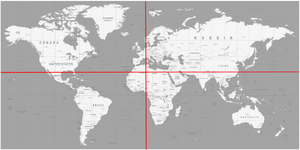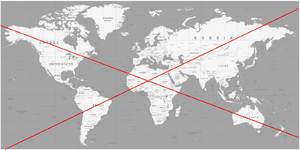Orthogonality: Difference between revisions
(Created page with "In factorial analysis, "orthogonality" refers to variables that are independent and uncorrelated. When two factors are orthogonal, you can study their effects as if they are happening at a right angle to each other, rather than overlapping. This leads to a clearer understanding of each factor's contribution to the outcome. The opposite of orthogonal factors are oblique factors. right|300px Consider the world map on the right. You may like...") |
No edit summary |
||
| Line 1: | Line 1: | ||
In factorial analysis, "orthogonality" refers to variables that are independent and uncorrelated. When two factors are orthogonal, you can study their effects as if they are happening at a right angle to each other, rather than overlapping. This leads to a clearer understanding of each factor's contribution to the outcome. | =Introduction= | ||
The opposite of orthogonal factors are oblique factors. | In factorial analysis, "orthogonality" refers to variables that are independent and uncorrelated. When two factors are orthogonal, you can study their effects as if they are happening at a right angle to each other, rather than overlapping. This leads to a clearer understanding of each factor's contribution to the outcome. The opposite of orthogonal factors are oblique factors. | ||
The idea of orthogonality in personality factors came from the studies on the Five Factors Model, and factors that may be extracted as orthogonal or oblique. | |||
=Map Analogy= | |||
[[File:Orthogonal factors.png|right|300px]] | [[File:Orthogonal factors.png|right|300px]] | ||
Consider the world map on the right. You may like to locate an individual on this map with its longitude and latitude. Those two dimensions are orthogonal. | Consider the world map on the right. You may like to locate an individual on this map with its longitude and latitude. Those two dimensions are orthogonal. | ||
[[File:Oblique factors.png|right|300px]] | [[File:Oblique factors.png|right|300px]] | ||
You may as well locate the individual by two oblique factors, like this other map on the right. The first one is simply more practical than the second. | You may as well locate the individual by two oblique factors, like this other map on the right. The first one is simply more practical than the second. | ||
The same goes for behavioral dimensions that can be located by two, three, or four factors. Orthogonal factors allow for the location and description of behaviors when the factors are as distant from each other as possible. | |||
=GRI Factors= | |||
With GRI we have four factors that were devised to be as distant to each other as possible, thus covering the "map' of behavior in a way that can be more practical to analyze and use for locating and describing behaviors. The four factors are represented in the adaptive profiles | |||
Revision as of 06:06, 29 September 2025
Introduction
In factorial analysis, "orthogonality" refers to variables that are independent and uncorrelated. When two factors are orthogonal, you can study their effects as if they are happening at a right angle to each other, rather than overlapping. This leads to a clearer understanding of each factor's contribution to the outcome. The opposite of orthogonal factors are oblique factors.
The idea of orthogonality in personality factors came from the studies on the Five Factors Model, and factors that may be extracted as orthogonal or oblique.
Map Analogy
Consider the world map on the right. You may like to locate an individual on this map with its longitude and latitude. Those two dimensions are orthogonal.
You may as well locate the individual by two oblique factors, like this other map on the right. The first one is simply more practical than the second.
The same goes for behavioral dimensions that can be located by two, three, or four factors. Orthogonal factors allow for the location and description of behaviors when the factors are as distant from each other as possible.
GRI Factors
With GRI we have four factors that were devised to be as distant to each other as possible, thus covering the "map' of behavior in a way that can be more practical to analyze and use for locating and describing behaviors. The four factors are represented in the adaptive profiles


